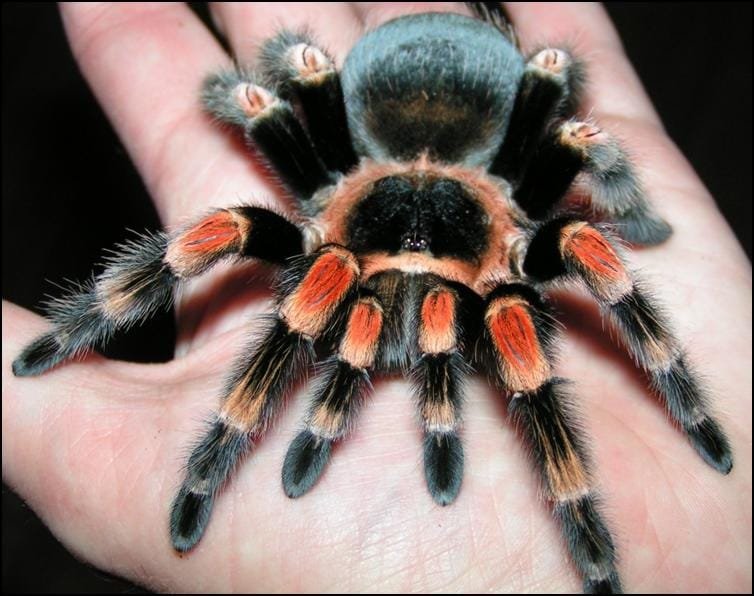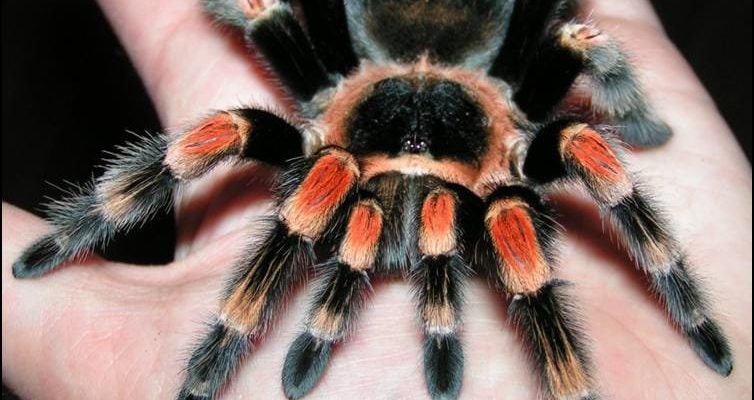
Imagine you’re meeting someone for the first time. You’d probably assess their vibe before diving into a conversation. The same goes for the Mexican Redknee Tarantula. Understanding their behavior and temperament can help you appreciate them without the panic that often accompanies the thought of spiders.
So, let’s get into the nitty-gritty of the Mexican Redknee Tarantula and unravel whether they’re truly dangerous or just misunderstood.
What is the Mexican Redknee Tarantula?
The Mexican Redknee Tarantula is a stunning spider, known for its beautiful appearance. With a body that’s mostly black and striking orange-red markings on its knees, it’s a sight to behold. They’re native to the dry regions of Mexico, thriving in scrublands and grasslands.
In the wild, they live in burrows, which they dig to escape the heat and predators. They’re not the biggest tarantulas out there, but they can grow to a leg span of about 4 to 6 inches. For some, that might sound intimidating. However, the size can be deceiving when it comes to their temperament.
You might also hear them referred to simply as “Redknees.” These little guys have become popular in the pet trade due to their attractive looks and relatively docile nature. But, before bringing one home, let’s dive a little deeper into their behavior.
Are Mexican Redknee Tarantulas Aggressive?
Here’s the thing: Mexican Redknee Tarantulas are not known for aggression. Unlike some spiders that might bite if they feel threatened, Redknees usually prefer to play it cool. They’re often described as *docile* and *calm*, which makes them a favorite among pet owners. If you’re thinking of keeping one, you might find yourself with a low-maintenance, friendly companion.
That said, every spider has its limits. If a Mexican Redknee feels cornered or frightened, it could resort to defensive behaviors, like hissing or raising its front legs. But biting is rare—especially compared to many other spider species. So, while they have the ability to defend themselves, they’re more likely to scuttle away from danger than put up a fight.
Just to give you a sense of their temperament, many enthusiasts describe handling them as a way to bond. If you introduce yourself slowly and carefully, you might just find they’re more curious than aggressive.
Is the Bite of a Mexican Redknee Tarantula Dangerous?
Now, let’s tackle what might be a big concern for many: the bite. You might be wondering, is it dangerous? The short answer is no, not really. While all spider bites can cause discomfort, the bite of a Mexican Redknee is generally considered harmless to humans.
In fact, many people compare their bites to a bee sting—unpleasant but not life-threatening. The venom isn’t potent enough to cause serious health issues in healthy adults, although some individuals might experience mild allergic reactions.
If you’re bitten, it’s crucial to keep the area clean and monitor any unusual symptoms. However, preventing bites is often as simple as understanding their body language and handling them gently. This means giving them space and not startling them when you’re around.
Here are some tips to avoid getting bitten:
- Be calm and move slowly when approaching them.
- Avoid sudden movements that might startle them.
- Only handle them when you’re comfortable and confident.
How to Properly Handle a Mexican Redknee Tarantula
If you’re ready to handle your Mexican Redknee, it’s essential to do it safely and stress-free for both of you. First off, make sure your hands are clean and dry. Wet or sweaty palms can create a slippery situation for the spider.
Here’s a simple step-by-step guide to handling your tarantula:
1. Choose the Right Time: Pick a time when your tarantula is active. Generally, these spiders are more active in the late afternoon or evening.
2. Create a Calm Environment: Set the scene by lowering loud noises and distractions. A quiet, peaceful space will help your spider feel at ease.
3. Gently Encourage Movement: You can coax your tarantula onto your hand by gently guiding its legs. Don’t try to force it; patience is key.
4. Limit the Time: Start with short handling sessions—just a few minutes at first. As both of you get accustomed to the process, you can gradually increase the time.
Remember, the goal here is to build trust and make it a positive experience for your tarantula, allowing you both to enjoy each other’s company.
What Makes the Mexican Redknee Tarantula a Good Pet?
If you’re considering adopting a Mexican Redknee Tarantula, you’re in for a unique experience. They’re relatively low maintenance compared to other pets, like dogs or cats. They don’t require daily walks or constant attention, which can be a huge plus for busy individuals.
Another appealing factor is their lifespan. Mexican Redknee Tarantulas can live for over a decade in captivity, sometimes even reaching 20 years! This long lifespan means you’re committing to something truly special.
And let’s not forget their striking appearance. Watching them move is like witnessing nature’s artistry in motion. They have distinct personalities too! Some may be more curious and active, while others prefer to be left alone. This variety can make each encounter an adventure.
When it comes to housing, they don’t need overly complicated setups. A simple terrarium with proper humidity and temperature can keep them happy. Plus, observing their behavior can be incredibly rewarding.
In a world filled with misconceptions about spiders, the Mexican Redknee Tarantula stands out as a fascinating and often misunderstood creature. They’re not the aggressive beasts many might think; instead, they’re generally calm and approachable. With their stunning looks and gentle nature, they can be rewarding pets for those willing to learn about their care and behavior.
So, the next time you hear someone say that tarantulas are dangerous, you can confidently share your newfound knowledge about the Mexican Redknee. They might just surprise you with their charm and grace. This tarantula isn’t just another spider; it’s a little piece of nature that can bring a lot of joy to the right owner. Whether you’re curious about keeping one or just want to learn more, appreciating these creatures can open up a world of wonder.

